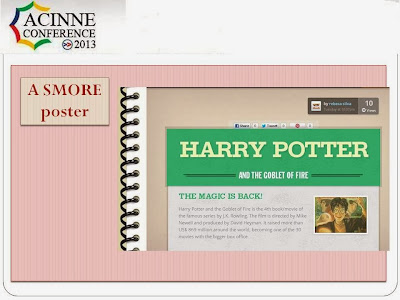Special thanks to Christina Martidou for the feedback (
Dimitris Primalis:)
At first it was the Communicative Approach, then the multiple intelligences theory, then the Multiple Intelligence theory, Learning Technology, 21st Century Skills and now the final straw ,
PBL - an exotic acronym for Project Based Learning.
It simply makes you wonder: Is it another fad I have to introduce and implement in my daily teaching or a flexible tool that can help me exploit all the aforementioned theories, and teaching methodology?
Time and practice will tell for sure but in the meantime, let me share a few thoughts and some useful tips and hints with you drawing upon my personal experience.
What's PBL?
Quoting verbatim from
Edutechwiki: " Project Based Learning is a teaching and learning model
( curriculum development and instructional approach) that emphasizes student-centred instruction by assigning projects. It allws students to work more autonomously to construct their own learning, and culminates in realistic, student-generated products."
The right approach or not?
" How much can I cram into my syllabus?" " When will I have time to do some real teaching?" Is this another show off? " These are just a few initial reactions to PBL and they only seem reasonable since overburdening your syllabus with extra project work doesn't usually sound appealing to anybody.
Graphs created by Dimitris Primalis
But is PBL really an extra feature? Project work is surely not new in ELT. It has always been part of the syllabus to a lesser or a greater extent. The crucial question here seems to be
how do we approach it effectively?
If projects are superimposed or chosen from a series of ready-made projects that cater little or not at all for your students' needs, then they are undoubtedly a burden. However, what if the projects were designed to serve your learners' needs and individual styles while reflecting the curriculum?
Synergy: forming an alliance to achieve learning goals:
Instead of devoting time to using technology, teaching literature, skills development , etc., separately, why not combine everything to achieve your class or even individual students' learning goals?
Graphs created by Dimitris Primalis
Learning technology devices such as laptops, tablets and mobile phones facilitate surveys, quests and anable students to take photos . share, store and present their work using PowerPoint, Keynote, Prezi - to name only some of the numerous software and Web 2.0 tools available. Still feeling that this is not enough?
What's more? Learners will see their critical thinking skills stretched to their limits when dealing with a huge amount of data and asked to select the most important snippets to include in their projects.
Well designed communicative activities - incorporated in the project - can help students develop their reading, listening, speaking and writing skills especially if the project involves joining forces with another school from another country. With PBL your students' accuracy and fluency will be given a crash test in stimulated-authentic tasks instead of "sterilized" and often decontextualized drills. Additionally, it's more likely that the teachers' feedback will receive more attention than the gap-fill exercises. A variety of delegated tasks can cater for different learning styles e.g. audio types can search for interviews or radio programmes related to the topic. Finally, chances are that research will motivate students who may not be keen on language learning but are into maths and science.
In the project described at the end of the post, the initial stimulus was provided by the coursebook. The linguistic aims ( describing/ presenting figures)were achieved while allowing for
ICT skills building and - equally important - 21st century skills practice ( communication, collaboration, critical thinking, presentations). All these were integrated in the project work instead of assigning different tasks with little or no relevance to the syllabus as is often the case.
Planning and Integrating:
One of the most crucial stages of this process is careful planning and wise integration of the project(s) into the syllabus at the beginning of the school year. The closest simile I can think of, is that of an army general's, planning his campaign. Before launching it, he would have to take the factors given below into account:
- the strategic goals
- the logistics (equipment , allocated time in class and at home, resources)
- his ´troops`current skills strengths and weaknesses
- existing and potential allies ( in this case , teachers of other subjects or EFL teachers from other schools abroad.
In other words, no matter how tempting some fancy projects may seem/sound, always consider :
- What are the learning goals for the class?
- How many of these goals can the project serve?
- How can it cater for different learning styles?
- What means (learning technologies) are available and in working order?
- How close is it to the students' interest /reality? (personalization)
- To what extent are students expected to be involved?
- Which aspects of the existing syllabus ( grammatical, lexical, functional) can blend in with the project?
- How much time can your students devote at school and at home?
- To what extent can your students develop their own initiative and creativity?
A project with my 6th graders (aged 11-12):
Photo taken from Access 4 - Interactive Coursebook (courtesy of Express Publishing)
Based on the text shown in the photo above, students were asked to carry out a survey on the most popular gadgets among family and friends. A the time, internet-based survey tools such as surveymonkey were not widespread so learners had to create questionnaires by themselves. In groups of four, they decided on the questionnaire ( which gadget to include and the questions they wanted to ask). Then, each student had to fill in 8 questionnaires asking family or friends - preferably in English. After that, they were asked to figure out percentages and transfer data on a PowerPoint graph ( I showed them how to enter data but it could easily have been done by an ICT teacher at school. Finally , students had to present their findings in class and attempt to exploit to the maximum the school's and learners' newly acquired equipment ( 1 tablet per student , IWB). Even though we overestimated the learners' ICT skills, the project stimulated their interest and their presentations sparked a discussion in class about data presentation.
To see some projects from
Douka School in Greece click
here.
My PBL:
It would be misleading to claim that introducing and implementing PBL in class is a breeze. Very often, what seems to work on paper wonderfully, fails in practice miserably and your initial estimate for the degree of your learners' autonomy (how much guidance they need) falls spectacularly short of the original prediction. Eventually, it all comes to a critical dilemma:
- Should I pretend that I apply PBL to abide by what the Director of Studies has asked me to do and impress parents or
- Do I use it as a tool - combining the technological and methodological means available- to give my students the opportunity to further develop their skills?
To my mind, it can be just another
Pe
BLe swept by the tide or - paraphrasing the lyrics of the song
" Make a Wave" - "
you can throw a PBL in the class waters and make a wave".
The choice is yours!
Dimitris Primalis
Useful link:
The author of this post:
Dimitris Primalis has been anEFL teacher for more than 20 years and is an examiner for the Cambridge English Language Assessment. He is also a materials designer and has published 5 test books for Macmillan.
Dimitris is particularly interested in innovation and change in the syllabus. He likes to share his experiences in the EFL field with colleagues at conferences ( IATEFL, TESOL France, TESOL Macedonia-Thrace, Nothern Greece), in his column in the BELTA bulletin and through articles (IATEFL Voices, ELT News) and blogposts. He is currently working at Doukas primary school in Athens , Greece.





















































